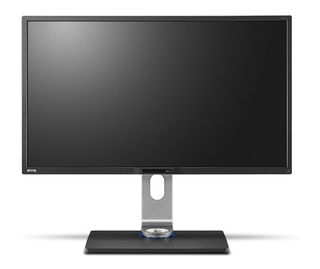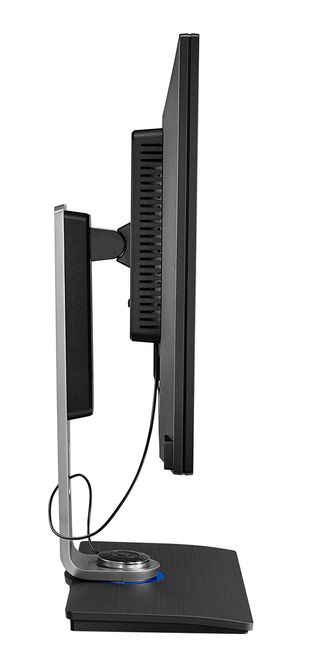BenQ BL3200PT Review: A 32-Inch AMVA Monitor At 2560x1440
The extra pixel density of a 27-inch monitor sporting a native 2560x1440 resolution can make small text difficult to read. BenQ solves the problem by adding five extra inches to its BL3200PT. Today we test this jumbo 32-inch AMVA-based panel in our lab.
Packaging, Physical Layout and Accessories
For such a large monitor, the BL3200PT’s carton is smaller than you’d expect. The contents seem well-protected, though we feel BenQ's packaging could be a little deeper to provide a greater buffer against damage. We suggest mail-order buyers check their shipment carefully before signing.
The cable bundle is quite extensive. There’s an IEC power cord for the internal power supply plus HDMI, DVI, DisplayPort, VGA, USB 3.0, and an analog audio cable. A CD contains the user manual, and there’s a printed quick start guide as well.
Assembly consists of attaching the base to the upright and snapping it onto the back of the panel.
Product 360

The first thing that struck me about the BL3200PT was its solid-aluminum upright. It’s a beautifully finished piece that drips with quality. It has a large hole to pass cables through, and attaches to the base with a captive wing-nut.
The screen’s anti-glare layer is mild for better clarity, but still controls reflections very well. Only a light source pointed directly at the BL3200PT is visible. The bezel is narrow, which makes this gargantuan display a great candidate for multi-monitor installations. If you put three of these things on your desk, they'd probably look like a commercial flight simulator.

The base is plastic finished to look like brushed metal. The little disc-shaped controller plugs into a dedicated mini-USB port and has four programmable buttons, plus menu navigation and a selector at the center. It’s well-designed and makes using the OSD quick and easy. The controller sits nicely in a little nest as pictured, or you can put it on your desk. In fact, it reminds me of the S-switch that comes with the XL2720Z.

If you have the room, the BL3200PT can be rotated to an impressive-looking portrait mode. You also have 25 degrees of tilt, 90 degrees of swivel, and almost six inches of height adjustment. Thanks to the most solid base and upright we’ve ever seen, all of the movements are firm and confident. The panel stays put with no slop or wobble whatsoever.
Stay on the Cutting Edge
Join the experts who read Tom's Hardware for the inside track on enthusiast PC tech news — and have for over 25 years. We'll send breaking news and in-depth reviews of CPUs, GPUs, AI, maker hardware and more straight to your inbox.

At 2.7 inches thick, the BL3200PT is no deeper than any of the smaller monitors we’ve tested. It won’t quite sit flush on a wall because of the power bulge, but it is slimmer than BenQ's dimensions suggest.

From the back you can see that the vents and speaker grills are located in the bulge, rather than the edges of the panel. The speakers boast a little more power than usual: five watts instead of two. They have a bit more sonic depth, but are still inadequate for serious gaming or movie-watching. Removing the upright reveals a 100 mm VESA mount.

The BL3200PT is fairly unique in that it has a side-facing input panel. You get one DVI, HDMI, DisplayPort, and VGA port. The only way to use the monitor’s full resolution at 60 Hz is through DVI or DisplayPort, though. You can also see two of the USB ports, the SD card reader, and the headphone jack. The remaining USB ports, OSD controller connector, and audio input are on a down-facing panel.
Current page: Packaging, Physical Layout and Accessories
Prev Page A 32-Inch QHD AMVA Monitor Next Page OSD Setup and Calibration
Christian Eberle is a Contributing Editor for Tom's Hardware US. He's a veteran reviewer of A/V equipment, specializing in monitors. Christian began his obsession with tech when he built his first PC in 1991, a 286 running DOS 3.0 at a blazing 12MHz. In 2006, he undertook training from the Imaging Science Foundation in video calibration and testing and thus started a passion for precise imaging that persists to this day. He is also a professional musician with a degree from the New England Conservatory as a classical bassoonist which he used to good effect as a performer with the West Point Army Band from 1987 to 2013. He enjoys watching movies and listening to high-end audio in his custom-built home theater and can be seen riding trails near his home on a race-ready ICE VTX recumbent trike. Christian enjoys the endless summer in Florida where he lives with his wife and Chihuahua and plays with orchestras around the state.
-
npyrhone "Remember that 92 ppi number we mentioned at the beginning of today's story? That seems to be a sweet spot. It works fine at 24 inches if your screen is FHD. You won’t discern individual pixels, but you’ll be quickly wishing for more screen real estate. Moving up to 2560x1440 at 27 inches increases density to 109 ppi. That’s great for gaming and photo work. However, text and small objects become difficult to see for many users."Reply
I can't understand why I would need a monitor with lower pixel density? Why not just zoom the text a notch in your word processor or whatever software you are using? Of two otherwise similar monitors I would always choose the one with higher PPI, even if I used it only for word processing. -
kid-mid I rather have the 27" QNIX Evo II 1440p for $300 or the ROG Swift for $600.Reply
The days of 60Hz are almost over with.. -
moogleslam ReplyI rather have the 27" QNIX Evo II 1440p for $300 or the ROG Swift for $600.
Except that the Swift cost $800
The days of 60Hz are almost over with.. -
Merry_Blind "The only complaint we’ve registered along the way involves font size. With a pixel density of 109 ppi, text in most Windows applications becomes pretty small."Reply
That's why I don't understand people saying 1080p is crap and has to go away. I've always find that even at 1080p, the fonts are really small, and icons and interfaces in general are very tiny. In my case, it's not even a case of not being able to read, it's just that everything looks so out of place and hideous, like, Windows wasn't meant for such resolutions.
I can't imagine 1440p. Must be ridiculous to look at. It's just aesthetically not nice.
Bring on the downvotes... -
animalosity Why in God's green earth would you pay $1000 for a 1440p display at 60hz when you can get a 4K for way less than that now. Rather have UHD....Reply -
Bondfc11 I agree with npyrhone - there are ways to enlarge everything on your screen if the density is too low. Having said that - this is an interesting panel. However, I cannot wait for the days when not TNs, but also IPS and VA panels (in large formats) become standard at 120Hz. The hertz do make a noticeable difference in everything you do on the screen.Reply -
ohim I`ll wait to see what Active Sync monitors will be able to do , an IPS with Active sync over a TN with 144hz.Reply -
Merry_Blind ReplyI`ll wait to see what Active Sync monitors will be able to do , an IPS with Active sync over a TN with 144hz.
What is Active Sync? -
Merry_Blind ReplyWhy in God's green earth would you pay $1000 for a 1440p display at 60hz when you can get a 4K for way less than that now. Rather have UHD....
It's not 1000$ though...
Most Popular

